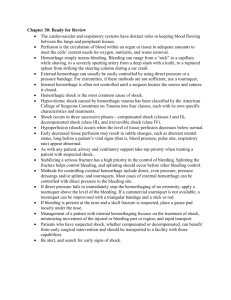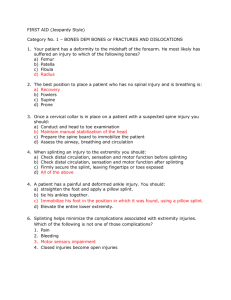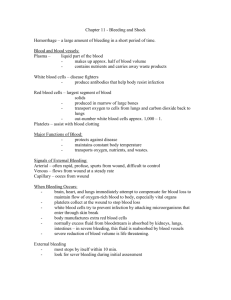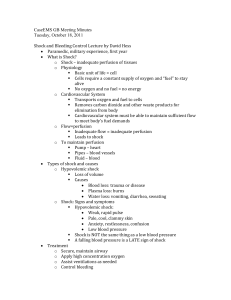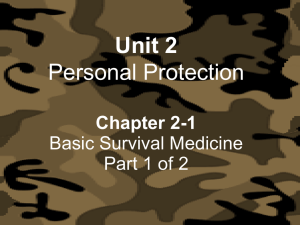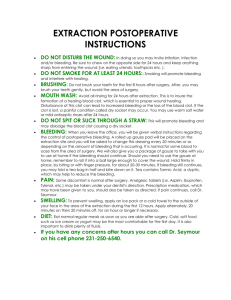Bleeding and Shock
advertisement
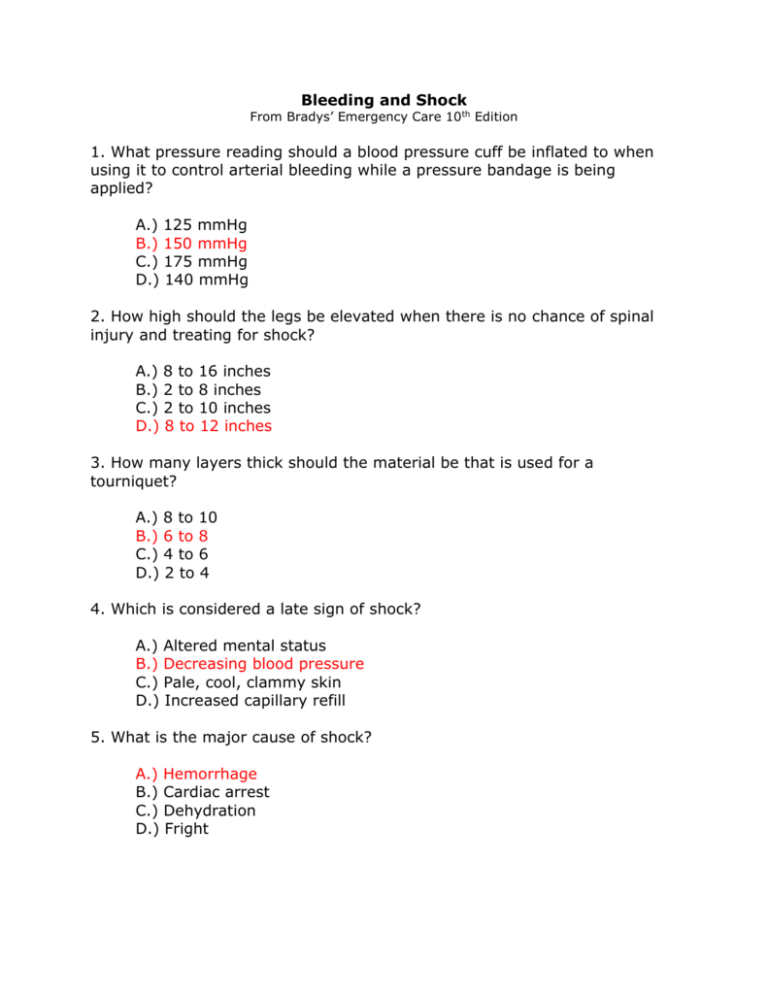
Bleeding and Shock From Bradys’ Emergency Care 10th Edition 1. What pressure reading should a blood pressure cuff be inflated to when using it to control arterial bleeding while a pressure bandage is being applied? A.) 125 mmHg B.) 150 mmHg C.) 175 mmHg D.) 140 mmHg 2. How high should the legs be elevated when there is no chance of spinal injury and treating for shock? A.) 8 to 16 inches B.) 2 to 8 inches C.) 2 to 10 inches D.) 8 to 12 inches 3. How many layers thick should the material be that is used for a tourniquet? A.) 8 to 10 B.) 6 to 8 C.) 4 to 6 D.) 2 to 4 4. Which is considered a late sign of shock? A.) Altered mental status B.) Decreasing blood pressure C.) Pale, cool, clammy skin D.) Increased capillary refill 5. What is the major cause of shock? A.) Hemorrhage B.) Cardiac arrest C.) Dehydration D.) Fright 6. Which is the correct order of the signs of shock? A.) Pale, cool, clammy skin B.) Altered mental status C.) Vital sign changes D.) Nausea and vomiting 7. What is the severity of blood loss related to? A.) Patient's condition B.) Patient's ethnicity C.) Patient's location D.) Patient's history 8. What position should the patient be placed in when controlling a nosebleed? A.) Laying on the left side B.) Sitting, leaning forward C.) Laying on the right side D.) Sitting, leaning backward 9. Where should the pressure bandage be secured when using it to control external bleeding? A.) On, above and below the wound B.) Above and below the wound C.) On and below the wound D.) On and above the wound 10. What sign exists when the lower compartments of the anti-shock garment are full enough? A.) Velcro crackles B.) Velcro seals C.) Velcro tears D.) Velcro snaps 11. What is a tourniquet most often used on? A.) Internal bleeding situations B.) Multiple wounds on one extremity C.) Rough edged amputations D.) Severely bleeding wounds 12. What should be looked for when examining a patient with a penetrating wound? A.) Lumps B.) Entrance wound C.) Sign of infection D.) Exit wound 13. What happens to the patient's pulse who is experiencing shock? A.) Increases B.) Remains stable C.) Decreases D.) Fluctuates 14. Which type of shock is most commonly seen by the EMT-B? A.) Cargiogenic B.) Hypovolemic C.) Neurogenic D.) Perfusive 15. What is the leading cause of internal injuries and bleeding? A.) Poison ingestion B.) Blunt trauma C.) Foreign object ingestion D.) Penetrating trauma 16. Which carries oxygen-rich blood away from the heart? A.) Areoli B.) Capillary C.) Vein D.) Artery 17. Which is NOT among the most sensitive to inadequate perfusion? A.) Liver B.) Spinal cord C.) Brain D.) Kidneys 18. Which is NOT considered a major method of controlling external bleeding? A.) Pressure points B.) Direct pressure C.) Elevation D.) Tourniquet 19. Which type of bleeding often spurts with each heartbeat? A.) Capillary B.) Venous C.) Arterial D.) Spinal 20. What is the goal for on-scene time when treating a shock patient? A.) 40 minutes B.) 10 minutes C.) 30 minutes D.) 50 minutes 21. What is the most common and effective way to control external bleeding? A.) Pressure points B.) Direct pressure C.) Splinting D.) Elevation 22. Which artery can be pressed upon to help control bleeding in the upper extremities? A.) Radial B.) Femoral C.) Brachial D.) Carotid 23. What is the maximum distance from the wound that a tourniquet should be placed? A.) 5 inches B.) 4 inches C.) 2 inches D.) 3 inches 24. What is the result of untreated shock? A.) Cardiac arrest B.) Death C.) Amputation D.) Deformation 25. Which type of shock is caused by an inadequate pumping action of the heart? A.) Neurogenic B.) Hypovolemic C.) Hemorrhagic D.) Cardiogenic 26. Which of the following would be useful when there are several injuries to the same extremity? A.) Cold application B.) Pressure points C.) Tourniquet D.) Air splint 27. Which stage of shock begins when the body can no longer compensate for the low blood volume? A.) Compensated B.) Reversible C.) Decompensated D.) Irreversible 28. What is the most significant treatment of the shock patient? A.) Keeping him warm B.) Transportation C.) Bleeding control D.) Oxygen administration 29. What part of the hand should be used when using pressure points for bleeding in the lower extremities? A.) Heel B.) Palm C.) Back D.) Finger

